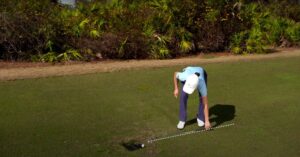Golf Chipping Vs Pitching: When To Use Each Shot In The Game
Short game shots are some of the most important shots in golf, and two of the most common types of short game shots are chipping and pitching. While they may seem similar, there are some key differences between the two.
The main difference between golf chipping and pitching is the trajectory of the ball. Chipping is a low-trajectory shot that stays low to the ground, while pitching is a higher-trajectory shot that lands softly on the green. The choice between the two depends on the lie, distance to the hole, and other factors.
In this article, we’ll compare golf chipping and pitching to help you understand when to use each one.
Golf Chipping Vs. Pitching: What Are The Differences?

Golf chipping and pitching are two important techniques used to hit the ball close to the hole when you are near the green. They have some key differences that every golfer should know to improve their short game skills.
| Aspect | Golf Chipping | Golf Pitching |
| Club Selection | Usually a lower lofted club (7-9 iron, PW) | Typically a higher lofted club (e.g., sand wedge) |
| Trajectory | Low, ball rolls more on the ground | Higher, ball lands softly on the green |
| Swing Length | Shorter swing | Longer swing |
| Ball Position | Back of the stance | Center or slightly forward in the stance |
| Shot Distance | Short distances, closer to the green | Longer distances, from 10-50 yards or more |
| Use of Hands | Less wrist action, more arm movement | More wrist action, less arm movement |
| Green Conditions | Used on firm or tight lies near the green | Suitable for shots requiring height and spin |
Club Selection
Chipping uses clubs with lower lofts, like 7-9 irons or pitching wedges (PW). These clubs have less loft, which means the ball will fly lower and roll more on the ground after it lands.
On the other hand, pitching involves using clubs with higher lofts, such as sand wedges or lob wedges. These clubs have more loft, so the ball will go higher in the air and stop more quickly on the green.
Trajectory
When you chip the ball, it stays closer to the ground, like a little rolling adventure towards the hole.
The trajectory is lower because you want the ball to land on the green and roll towards your target.
In pitching, you want the ball to go up higher in the air, like a soft floating cloud. It lands more gently on the green, making it easier to stop the ball where you want it.
Swing Length
The swing length is different for chipping and pitching. When you chip, you use a short and simple swing.
It’s like a little tick-tock motion, just like a clock’s pendulum. For pitching, your swing is longer, like a big rainbow.
You need more power to send the ball higher and farther with a pitching swing.
Ball Position
Where you place the ball in your stance is important for chipping and pitching. When you chip, you put the ball back in your stance, closer to your back foot.
This helps you hit down on the ball and make it roll nicely. When you pitch, the ball is more in the middle or slightly closer to your front foot. This helps you hit the ball up into the sky.
Shot Distance
Chipping and pitching shots are used for different distances from the hole. Chipping is for shorter distances, like when you are close to the green. You want the ball to roll a bit after it lands.
Pitching is for longer distances, like when you are a bit farther from the green. You need the ball to go higher in the air to reach the target.
Use Of Hands
In chipping, you use your hands less and rely more on your arms to swing the club. It’s like a smooth robot motion with your arms.
But in pitching, you use your hands more, and they get to do a little dance with the club. It helps you add spin to the ball and control where it goes.
Green Conditions
The condition of the green can also guide your choice between chipping and pitching. Chipping works well on firmer or tight lies near the green because the ball can roll smoothly.
Pitching is better for softer greens or when you need the ball to stop quickly on the green, like a soft pillow landing.
Golf Chipping Vs. Pitching: What Are The Similarities?

When it comes to the short game in golf, chipping and pitching are two of the most important shots. While they require different techniques and clubs, there are some similarities between the two shots.
Setup
Both chipping and pitching require a similar setup. Golfers should position their feet shoulder-width apart, with the ball placed slightly back in the stance, and the hands slightly ahead of the ball.
This setup promotes a downward strike on the ball, ensuring clean contact and a controlled shot.
Swing Mechanics
The swing mechanics for chipping and pitching are alike in many ways. Golfers use a relatively short backswing and a controlled wrist hinge to generate power and accuracy.
The focus is on maintaining a steady tempo and making a clean strike on the ball, rather than relying on raw strength.
Precision And Distance Control
In both chipping and pitching, precision and distance control are crucial.
Whether executing a short chip shot near the green or a longer pitch shot to clear a bunker, golfers must judge the appropriate amount of force needed to reach the target accurately.
Green Reading
Both chipping and pitching involve reading the green and understanding how it will influence the roll or bounce of the ball. Golfers must analyze the slope, grain, and speed of the putting surface to plan their shots effectively.
Mental Approach
The mental aspect of chipping and pitching is similar, requiring focus, confidence, and composure. Golfers must visualize the shot they want to execute and trust their skills to deliver the ball to the target.
Golf Chipping Vs. Pitching: Which One Is Better?
Golf chipping and pitching are both crucial short game skills that golfers must master to improve their scores. Chipping involves using a variety of clubs, typically 7-iron or wedge, to make short, low-flying shots that roll more on the green.
On the other hand, pitching requires lofted clubs like sand or lob wedge to create high shots that stop quickly on the green. While both techniques are essential, chipping is generally considered more versatile and easier to control.
It allows golfers to adapt to different situations around the green with greater precision. Therefore, for overall effectiveness and versatility, chipping is often considered the better option for most golfers.
Frequently Asked Questions
Discover the differences in ball position, club selection, trajectory, and when to choose each technique for optimal results on the course.
Here, we’ll explore some common questions of golf chipping and pitching to enhance your skills around the green.
How Is The Ball Position Different?
For chipping, the ball is positioned back in the stance, closer to the golfer’s back foot. In pitching, the ball is more centrally placed in the stance.
What About The Club Selection?
Chipping usually involves using a club with less loft, while pitching requires a club with more loft.
How Do They Differ In Trajectory And Roll?
Chipping produces a lower trajectory with more roll, while pitching generates a higher trajectory with less roll.
Which One To Choose When?
Use chipping when you have a short distance to cover and plenty of green to work with. Pick pitching when you need to carry the ball over an obstacle or stop it quickly on the green.

![Does 1 Degree Lie Angle Make Difference In Golf Shots? [Explained] Does 1 Degree Lie Angle Make Difference In Golf Shots? [Explained]](https://giftedgolfers.com/wp-content/uploads/2023/05/image-112-1024x538.png)


![How To Hang Golf Towel With Hole In Middle? [Complete Guide] how-to-hang-golf-towel-with-hole-in-middle](https://giftedgolfers.com/wp-content/uploads/2023/06/how-to-hang-golf-towel-with-hole-in-middle-300x157.jpg)

